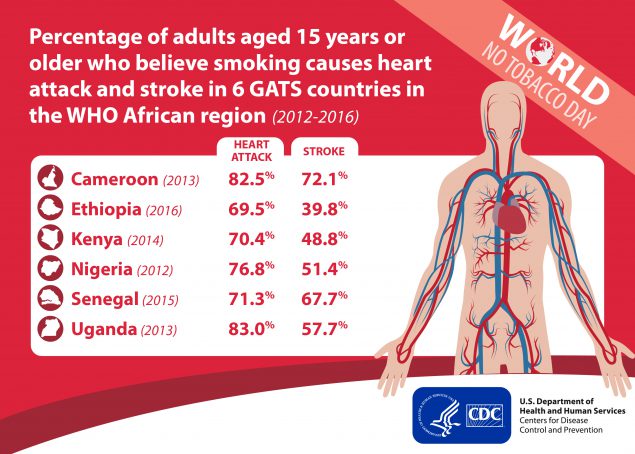Tobacco Control and Heart Health: Using Data to Help Reduce Tobacco Use and Prevent Cardiovascular Disease in Africa

A Global Adult Tobacco Survey field-interviewer conducts an interview in Tanzania.
Tobacco use is a leading cause of preventable disease, disability, and death in the world. Currently, over 7 million people die from tobacco use each year worldwide, including 890,000 from exposure to secondhand smoke. The majority of these deaths occur in the developing world.
Tobacco use and secondhand smoke exposure can cause cardiovascular disease. Cardiovascular diseases affect the heart and blood vessels, and include heart disease and stroke. Over 17 million people die from cardiovascular disease each year worldwide. Around 10% of all cardiovascular disease deaths worldwide are attributed to tobacco use, and tobacco use is a leading cause of cardiovascular disease.
To address the burden of tobacco use on society, the World Health Organization’s (WHO) Framework Convention on Tobacco Control (see Article 20) calls for global surveillance of tobacco use, exposure to secondhand smoke, and tobacco-related health outcomes.
In alignment with this call, CDC collaborates with WHO and other partners to help countries collect data on key tobacco control indicators through the Global Tobacco Surveillance System (GTSS). GTSS includes the Global Adult Tobacco Survey (GATS), a household survey that collects data on people aged 15 years or older. GATS provides a global standard for systematically monitoring adult tobacco use and key tobacco control measures.
It is estimated that without comprehensive tobacco prevention and control efforts, the smoking prevalence in sub-Saharan Africa will rise from 15.8% in 2010 to 21.9% in 2030. As of 2017, there were 6 countries within the WHO African region with GATS data available to the public: Cameroon (2013), Ethiopia (2016), Kenya (2014), Nigeria (2012), Senegal (2015), and Uganda (2013). Among those countries, tobacco use among adults aged 15 years or older ranged from 5.0% in Ethiopia to 11.6% in Kenya (see Figure 1). It is estimated that there were over 13 million tobacco users in these 6 WHO African region countries.

CDC’s Indu Ahluwalia travels with survey interviewers to observe data collection for the Global Adult Tobacco Survey in Tanzania.
There is variance in the knowledge of how smoking tobacco causes cardiovascular diseases such as heart attack and stroke between GATS countries in the region. Among these 6 countries in the African region, more than two-thirds of adults believed that smoking causes heart attack, which ranged from 69.5% in Ethiopia to 83.0% in Uganda. The proportion of adults who believe smoking causes stroke ranged from 39.8% in Ethiopia to 72.1% in Cameroon (see Figure 2).
In addition to these 6 countries, there are 2 countries in the African region that are currently in the process of implementing a GATS survey: Botswana and Tanzania. Botswana finished collecting GATS data and attended a data analysis workshop in Atlanta, Georgia, in April 2018; the country is planning to release their results in the upcoming months. Tanzania started full-survey fieldwork in February of 2018, and completed data collection in April. The country is currently conducting data management and analysis.
Dr. Sarah Maongezi, the coordinator of non-communicable disease at the Ministry of Health in Tanzania helped facilitate and supervise the National Bureau of Statistics during the implementation of GATS in Tanzania. Now that Tanzania has completed collecting GATS data, Dr. Maongezi eagerly awaits the results because they could provide useful information on where Tanzania stands in terms of the population of adults who smoke, interventions to help adults stop smoking, and to prevent adults from ever starting to smoke.
Once Dr. Maongezi and her colleagues from Tanzania have completed their data analysis from the GATS survey, the results will be disseminated to help inform tobacco control and prevention strategies in the country.
To assist countries with the implementation and management of tobacco control strategies, the WHO introduced MPOWER. These measures include:
- Monitor tobacco use and prevention policies.
- Protect people from secondhand smoke exposure.
- Offer help to quit tobacco use.
- Warn about the dangers of tobacco use.
- Enforce comprehensive bans on tobacco advertising, promotion, and sponsorship.
- Raise taxes on tobacco products.
Implementing WHO’S MPOWER measures can reduce tobacco use and help protect people from exposure to secondhand smoke. Reducing the number of people who use tobacco and who are exposed to secondhand smoke can protect people from non-communicable diseases, including cardiovascular diseases.

